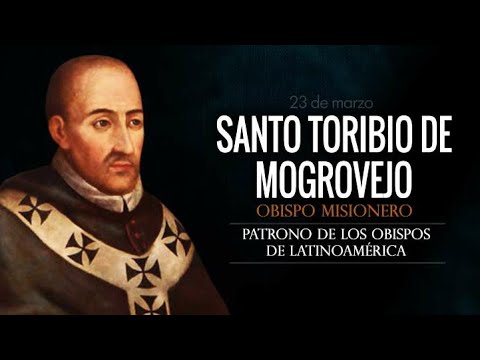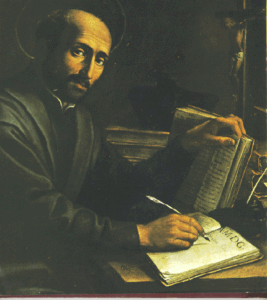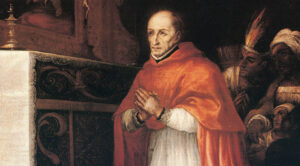
St. Turibius of Mogrovejo was a Spanish missionary, bishop, and Church reformer. Turibius was born in 1538 to Luis Alfonso de Mogrovejo and his wife Ana at Mayorga, Spain. Luis was a governor, and his children were well-educated, in keeping with the family’s status as nobility. Turibius was an exceptionally bright and pious child, who had a particular devotion to the Virgin Mary. Even as a child, he was generous with the poor and recited the Rosary daily. At age twelve, he went to the college at Valladolid and studied humanities and law. He then continued his studies at the colleges at Salamanca and at Coimbra, and he became a law professor at Salamanca.

A COMPLETELY NEW VOCATION
His reputation for wisdom and eloquence reached King Philip II, and he was appointed chief judge of the Court of the Inquisition at Granada in 1571. Since he served with much distinction, the King in 1580 appointed him to be the second Archbishop of the colonial diocese of Peru. Since Turibius was not a priest, he objected strenuously to this appointment, pointing out that he was unfit for such a position. He recalled the canon laws forbidding such an appointment and protested for three months. But since the Vatican supported the appointment, he conceded. After a relatively short period of preparation, he was ordained a priest and consecrated a bishop, named by Pope Gregory XIII.
ARRIVAL IN THE NEW WORLD
Turibius arrived in Piura in March 1581 and walked more than six hundred miles on foot to Lima. The archdiocese he was responsible for was vast – more than three million square miles – covering the present nations of Bolivia, Venezuela, Columbia, Ecuador, Peru, Chile, and part of Argentina. As their bishop, Turibius covered the parishes of the diocese in three separate years-long apostolic visitations, usually alone and on foot. He had to endure rushing rivers, snowstorms, mountainous terrain, tropical heat and humidity, dangerous wildlife, and unfriendly tribes. While making these visits, he taught, preached, and administered Sacraments. He had mastered the native Quechua language so that he would be able to reach people in their own familiar language. The Bishop was troubled by the lack of discipline among the priests, causing scandal with their worldliness and impurity, and he made great strides in correcting that problem. Morality was not lacking only among the priests, however. There were multitudes of people unacquainted with the Gospel and in great need of its saving message. The conquest of the pagan Incan Empire had recently taken place, and the wounds of this conflict were fresh, including cruelties inflicted by the Spaniards. Bishop Turibius faced some of the most appalling abuse by European colonialism, with many of the Spaniards doing whatever it took to be wealthy, including stripping the Peruvians of their rights. He was in frequent conflict with the authorities over the treatment of the poor, and tried valiantly to instill an awareness of their human dignity as being of greater value than the riches derived from the land’s natural resources.
TIRELESS LABORER
Bishop Turibius dedicated himself to establishing and organizing the Church in his diocese. He nearly doubled the number of parishes and had numerous churches, schools, convents and hospitals built. In 1582, he called and presided over the Third Council of Lima, which gathered together all the bishops of Latin America. From this, standards were set for how to properly evangelize indigenous people. In 1584, he produced a catechism in three languages for his people. In 1591, he established the first seminary in the New World, and required his priests in formation to learn the Quechua language. It was while he was on his third tour of the diocese that he became ill with a fever at Pacasmayo in the spring of 1606. He continued working until Holy Thursday, when he was clearly dying, and insisted to make his way to the chapel to receive Viaticum. He died shortly thereafter, March 23, 1606, at the Augustinian convent at Santa Clara/Saña/Zaña. He was sixty-seven. It took nearly a year for his body to be transported to Lima. When it arrived, it was discovered to look as if he had just died, and numerous miracles had already taken place.
IDEAL MISSIONARY BISHOP

St. Turibius of Mogrovejo devoted himself to the people entrusted to him with remarkable constancy, teaching, and preaching, making his efforts more fruitful by fidelity to prayer and acts of penance. Near the end of his life, he wrote a letter to Spain’s King Philip III, informing him that he had baptized and confirmed approximately five hundred thousand people. Among the people he influenced were four canonized saints; Rose of Lima, Martin de Porres, Francis Solano, and John Massias. He was beloved by the people who had been exploited by the colonists and they saw him as their advocate and benefactor, and he was so despite considerable opposition. For a long time, his life story was mostly known in South America. He has, however, become known worldwide as an ideal missionary bishop. He was canonized in 1726, and in 1983, he was named by Pope St. John Paul II as the patron saint of Latin American bishops. His feast day is March 23 (April 27 in Peru). His remains are in a reliquary in the Chapel of St. Turibius of Mogrovejo located within the Lima Metropolitan Cathedral.
